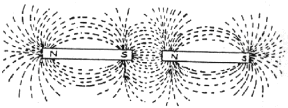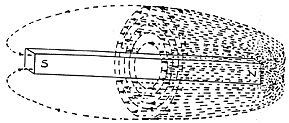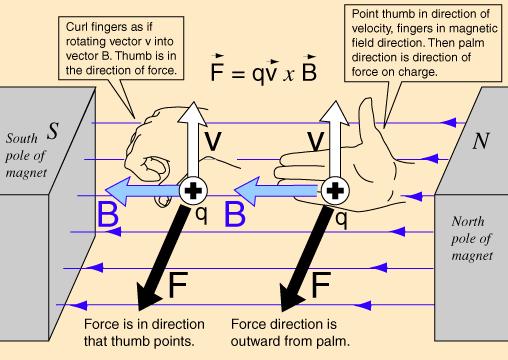Magnetic fields surround
any magnetic substance. They are "produced by electric currents"(http://hyperphysics.phy-astr.gsu.edu/hbase/magnetic/magfie.html#c1).
They are usually represented as lines as in the pictures below.
(Courtesy of http://www.sciencetech.technomuses.ca/english/schoolzone/Info_Magnets.cfm#whatare).
 <--Attract || Repel-->
<--Attract || Repel-->
As you can see the dotted lines
are representing the force fields. These are 3 dimensional and
travel all around an object like so (courtesy of http://www.sciencetech.technomuses.ca/english/schoolzone/Info_Magnets.cfm#whatare)

It is also important to note that
these magnetic fields always travel from the north pole to the
south pole. Magnetic fields always radiate out of the north pole
and magnetic fields always go in to the south pole. We define
a magnetic field with the symbol B. "The direction
of the magnetic field B at any location is the direction
in which the compass needle points at that location" (Serway).
We know the magnetic force by the equation and picture below provide
by (http://hyperphysics.phy-astr.gsu.edu/hbase/magnetic/magfor.html)

http://hyperphysics.phy-astr.gsu.edu/hbase/magnetic/magfor.html
also gives the implications of the expression.
"1. The force is perpendicular to both the
velocity v of the charge q and the magnetic field B.
2. The magnitude of the force is F = qvB sin where
is the angle < 180 degrees between the velocity and the magnetic
field. This implies that the magnetic force on a stationary charge
or a charge moving parallel to the magnetic field is zero.
3. The direction of the force is given by the right
hand rule. The force relationship above is in the form of
a vector
product.
From the force relationship above it can be deduced
that the units of magnetic field are Newton seconds /(Coulomb
meter) or Newton's per Ampere meter. This unit is named the Tesla.
It is a large unit, and the smaller unit Gauss is used for small
fields like the Earth's magnetic field. A Tesla is 10,000 Gauss.
The Earth's magnetic field is on the order of half a Gauss. "
Although the right hand rule is
linked above I felt it important to put the picture below just
because it is a concept often used when calculating magnetic field
problems. (Image provide by: http://hyperphysics.phy-astr.gsu.edu/hbase/magnetic/magfor.html)

This picture demonstrates two methods
of the right hand rule, the one I've seen used most often is the
one on the left.
With regard to the velocity of a
particle moving through a magnetic field, its direction can be
changed by the field but speed and kinetic energy of the particle
cannot be altered by the magnetic field. It is also important
to note that "when a charged particle moves in a magnetic
field, the work done by the magnetic force on the particle is
zero." We know this" because the displacement is always
perpendicular to the direction of the force"(Serway). Think
of it as if you were walking. The work done while walking is zero
because you are displacing forward and the direction of the force
is down (your feet striking down on the ground pushing you up).
If we are dealing with a charged
particle in a magnetic field, the particle moves in a circle perpendicular
to the magnetic field. It moves in this way because "the
magnetic force F sub b is at right angles to v and B and has a
constant magnitude qvB" (Serway). The force is deflecting
v and F sub b continuously. However, note that again although
the direction of the velocity changes, it does not change its
magnitude. A really cool webpage related to magnetic forces on
moving charges can be found here.
Depending on weather the magnetic field goes into or out of the
"circle" determines which direction the particle moves.
If the field is coming out of the page the particle moves in a
clockwise fashion. If the field is going into the page the particle
travels counterclockwise. This
page provides a real time demonstration of this. Same is true
depending on the charge. If the charge is positive(and the force
is pointing inward) it would move counterclockwise, and if the
the charge is negative (and the force is pointing inward) it would
move clockwise. Below is a visual and the equations for determining
radius and velocity.

(Image Courtesy of http://hyperphysics.phy-astr.gsu.edu/hbase/magnetic/maspec.html#c2)
Please continue the discussion of magnetic fields
here.


